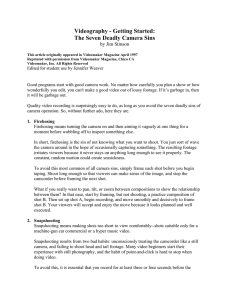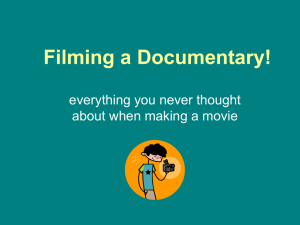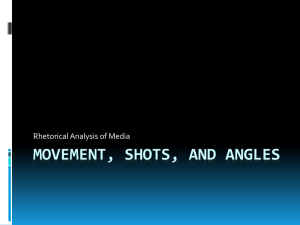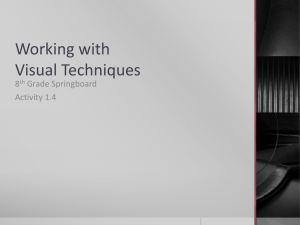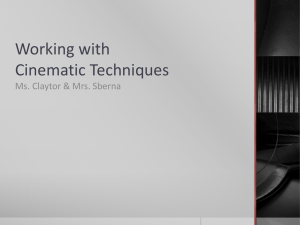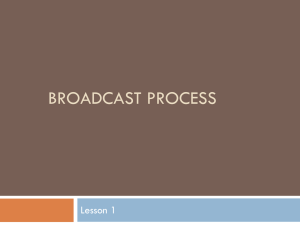Seven Deadly Camera Sins
advertisement
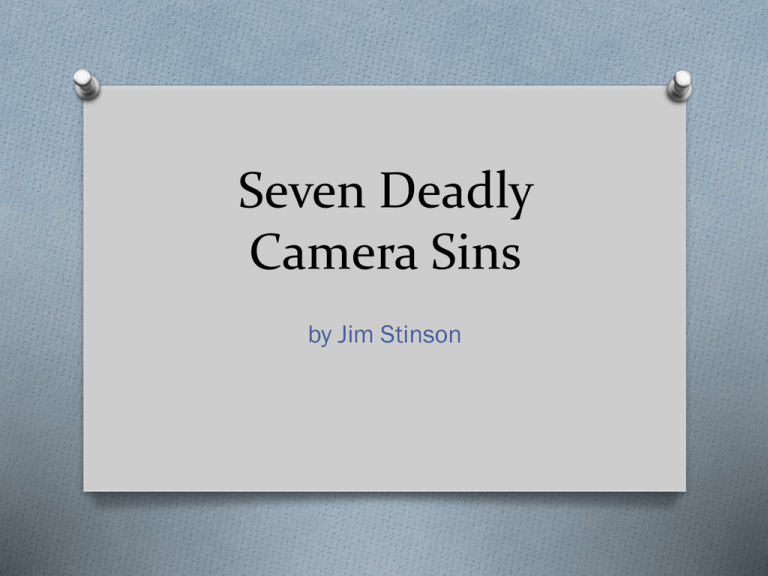
Seven Deadly Camera Sins by Jim Stinson Seven Deadly Camera Sins O Good programs start with good camera work. No matter how carefully you plan a show or edit your material, you can’t make a good video out of lousy footage. Garbage in, garbage out! O Quality video recording is surprisingly easy to do, as long as you avoid the seven deadly sins of camera operation! Seven Deadly Camera Sins O 1.) Firehosing O 2.) Snapshooting O 3.) Headhunting O 4.) Backlighting O 5.) Motorzooming O 6.) Upstanding O 7.) Jogging Firehosing O Firehosing means turning the camera on and then aiming it vaguely at one thing for a moment and jumping from subject to subject. O In short, firehosing is the sin of not knowing what you want to shoot. O You wave the camera around in the hope of capturing something, and because you never land on anything for more than an instant you irritate viewers and make them potentially seasick! How to avoid Firehosing O To avoid this most common of all camera sins, simply frame each shot before you roll tape. O Shoot long enough so that viewers can make sense of the image, and stop the camcorder before framing the next shot. O When you edit your footage, it’s o.k. to keep rolling while your waggling your way from shot A to shot B because you will delete the firehosing between the two when you edit. Avoiding Firehosing O What if you really want to pan, tilt, or zoom between compositions to show the relationship between them? O Start by framing, but not shooting, a rehearsal composition of shot B. O Then set up shot A, lay down the footage, and move smoothly and decisively to frame shot B. O Your viewers will accept and enjoy the move because it looks planned and well excecuted. Snapshooting O Snapshooting means making shots too short to view comfortably- shots suitable for a machine-gun car commercial or a hyper music video O Snapshooting results from two bad habits: O 1.) Unconsciously treating the camcorder like a still camera. O 2.) Failing to shoot head and tail footage. Snapshooting O It is essential that you roll tape at least three or four seconds before the action you want and another three or four after it apparently ends. O There are two important reasons for shooting this “bookend” material Snapshooting: Bookend material 1.) Leading footage starts recording a control track before the essential action begins. In editing, that track will display timecode numbers so that you can cue the shot to hit a precise edit point. 2.) Bookend footage offers you options in adjusting start and end points for the edited shot. Without head and tail footage, you’re stuck with the edit choices you made on the fly. Headhunting O Headhunting is framing subjects so that their eyes are in the exact center of the image: half way up and halfway down O Centering people is natural because that’s the way we look at them in real life, eye to eye. O Our human vision however does not have an unforgiving border around it and in this composition where it centers the eye looks well, dumb! How to Avoid Headhunting O Use your Rule of Thirds!! O Keep the subjects eyes on or above and imaginary horizontal line one-third of the way down from the top Backlighting O Backlighting is the sin of posing subject (usually one or more people) in front of a lit source so that the important foreground and subject darker than the unimportant background. O There is too much light exposure for the camera and the subjects become dark silhouettes How to avoid Backlighting O Notice your surroundings and study the image in your viewfinder. If it does not clearly show detail in people’s faces or other important foreground elements, you’ve got backlighting O Move the camcorder and subjects until the foreground of your shot is at least as bright as the background. O To eliminate sky start with a higher camera position O At the beach turn away from the glare off the water Motorzooming O Motorzooming is the sin of…zooming! No matter how nifty your camera features may be, onscreen zooms are a dull waste of viewer time and professionals don’t use them except in two circumstances: O 1.) Real-time coverage like news and sports, when the need to keep an image on the screen mandates zooming between compositions. O 2.) Situations that require a progressive revelation of the image: The dark figure at the door pulls a sinister tool from her pocket to reveal that it is (zoom in)…her door key! Avoiding Motorzooming O If you have a zoom lens, zooming is inescapable because it’s the only way to change image size without physically moving forward or back. O So….plan your shots to eliminate these zooms. O If not able to eliminate while shooting you can edit them out later. Upstanding O A sin of shooting everything from standing eye level O Much of the world is better viewed from higher or lower angles How to avoid Upstanding O Shoot children, pets, flowers, and other critters from their own levels. O Lower the tripod and tilt the view finder upward O Raise the camcorder for dramatic establishing shots O Even if the subject doesn’t require it, a new angle makes a welcome change from the endless progression of eye-level shots. Jogging O Jogging is the sin of walking while shooting. O Moving shots are dramatic and exciting, so go for them but to ensure that most of the movement is forward rather than up and down, observe these simple rules for hand held shooting: Avoiding Jogging O Zoom the lens to its wide-angle setting to minimize shake. The telephoto position magnifies the jitters along with everything else. O Don’t touch the viewfinder with your forhead (a snap if you have an LCD screen finder). O Walk with both knees and elbows bent so that your arms and legs act as natural shock absorbers. Avoiding Jogging O Move much more slowly than normal, so that the scene passing your lens has a chance to register with viewers. O Pretend the camcorder you’re carrying is a very full, very hot cup of cocoa—and you’d better not spill a drop!
